Early recognition is the first step to proper care.
Takeaways:
- Preventing concussions is the cornerstone of care.
- Recognition and proper care of concussion is a priority to prevent injury and promote wellness in the pediatric population.
- Nurses are key players in the push to increase recognition and standardize treatment, making a significant impact on the prevention, recognition, and post-concussion care of youth athletes.
By Margaret H. Granitto, MSN, ANP-BC, CNL, and Colleen Norton, PhD, RN, CCRN
Concussion, a subset of mild traumatic brain injury, can lead to long-term effects, including chronic traumatic encephalopathy. (See Concussion’s impact.) The Centers for Disease Control and Prevention (CDC) estimates that approximately 30 million children in the United States participate in sports that put them at risk for head trauma and concussion. And many young athletes who experience mild head trauma don’t report symptoms until hours after the injury.
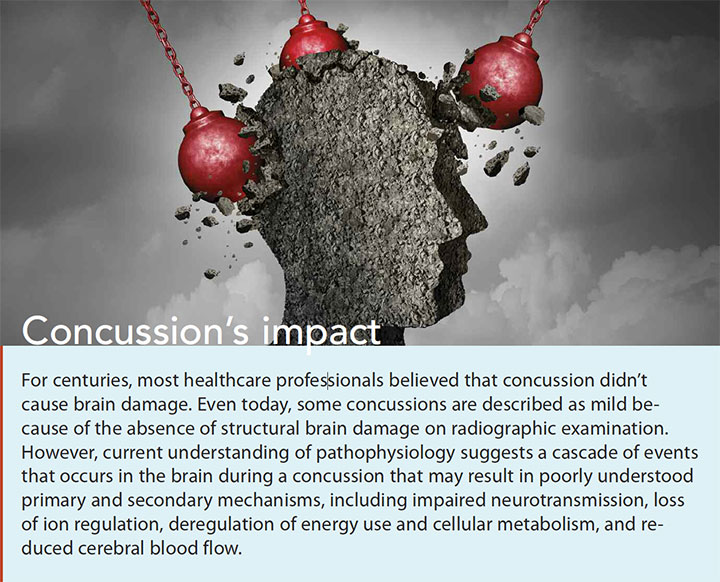

Prevention is the first step to reducing concussions among children and adolescents, but early-recognition will help ensure that young athletes receive proper care when they are injured.
Evolving guidelines
Although assessment and management of sports-related concussion
in children and adolescents has evolved, no definitive, evidence-based protocols exist. Several assessment algorithms and treatment protocols have been developed, but most recent studies have concluded that more research is needed.
In 2013, the Report of the Guideline Development Subcommittee of the American Academy of Neurology (AAN) published an update on the evidence regarding sports concussion recognition and treatment. (See AAN guidelines.) This comprehensive literature review from 1955 through 2012 found that although several factors influence recovery, no conclusive evidence supports specific postconcussion activities to mitigate developing chronic complications.
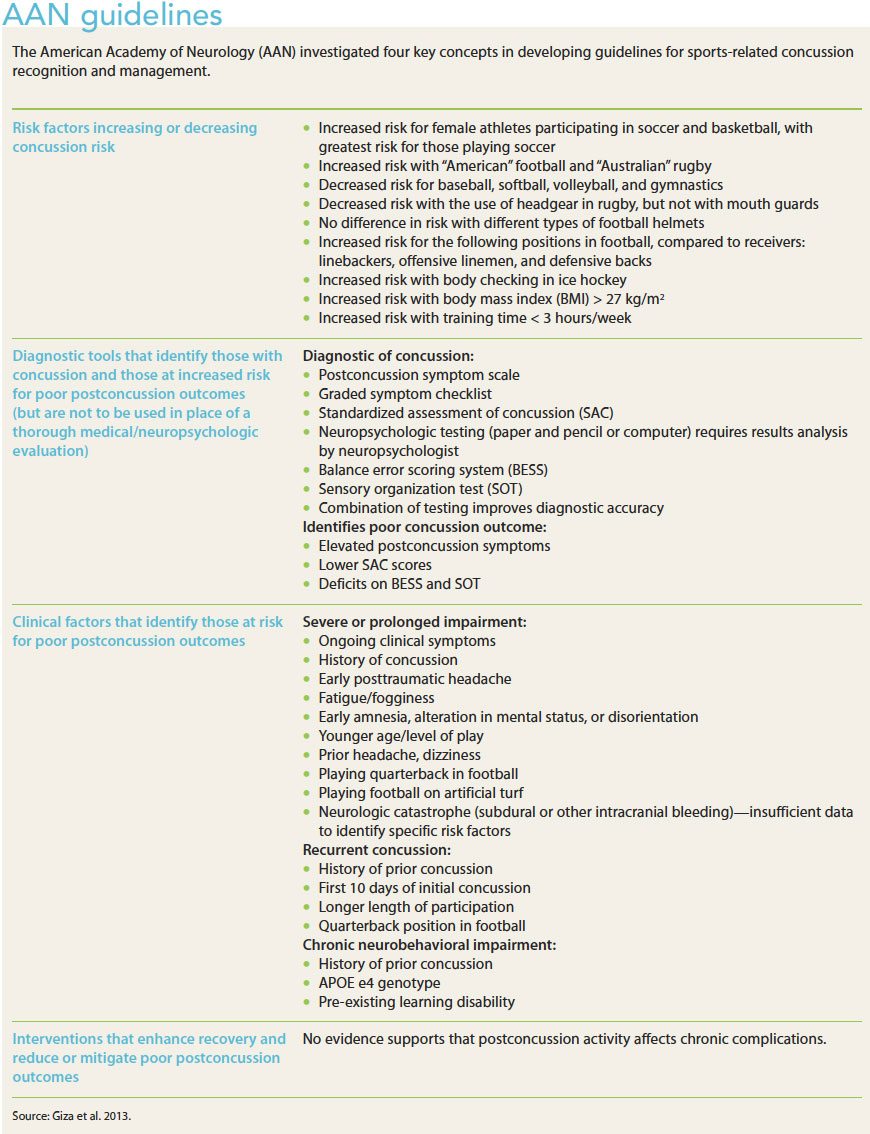

Practice recommendations generated from the data were organized into three categories: pre-participation counseling; assessment, diagnosis, and management of suspected concussion recommendations; and management recommendations for diagnosed concussion, including acute care, return to play (RTP), and retirement from play. Many of the recommendations are considered standard of care and are used across the country where sports concussion programs exist.
Pre-participation counseling
The role of prevention can’t be overstated. Research has led to the implementation of bans on body checks in PeeWee ice hockey, required helmet use when skiing or snowboarding, and mandatory car seats for children under a certain age or weight. Since 2009, most states have passed legislation on concussion in youth and high school sports, focusing on education, removal from play, and RTP.
The CDC Heads Up initiative and other programs offer comprehensive concussion education to students, parents, coaches, school personnel, and sports officials. Mandatory educational programs, through local or state agencies, are available for coaches, trainers, and healthcare providers.
Recent data demonstrate that many parents of young athletes aren’t well-informed about concussion facts. One study showed that only 25% of parents “had a basic understanding of sports-related concussion.” About 50% of the same group indicated their interest in learning more.
Another study revealed variability among school nurses about concussion recognition and management. Areas for improvement include continued training in recognition and management, establishing return to learn (RTL) school policies, and providing individualized approaches to concussion management. School nurses can play a leadership role in concussion recognition, care, and referral, and in coordinating and monitoring proper cognitive rest and academic accommodations.
Athletes and coaches also require concussion education. Many students don’t recognize or report an injury or symptoms, and coaches don’t always react quickly to a student’s complaints. Some coaches pressure healthcare providers for premature permission to RTP.
Assessment, diagnosis, and management
The most recent guidelines are from the American Medical Society for Sports Medicine, the American Academy of Neurology Summary of Evidence-Based Guideline Update, and the Consensus Statement on Concussion in Sport. All were published in 2013, and they all concur on early assessment and treatment goals.
Any youth athlete who’s suspected of head trauma must be immediately removed from play. This first step in recognition and care of suspected concussion protects the individual from sustaining further injury. Although rare, additional injury may lead to second impact syndrome (SIS) or other complications of concussion. (See What is SIS?)
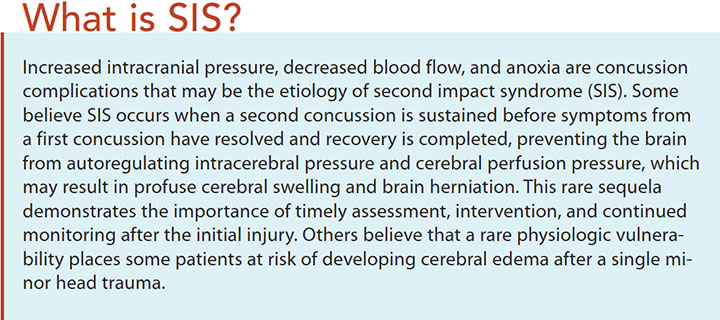

Assessment
Using sideline assessment tools, coaches, trainers, nurses, and providers can perform preliminary evaluation for concussion. (See Signs and symptoms of concussion.) Assessment tools include symptom scales, balance and gait testing, and cognitive assessments. Remember, these tools may help in early recognition, but they aren’t a substitute for a thorough medical or neurologic evaluation by a trained provider.
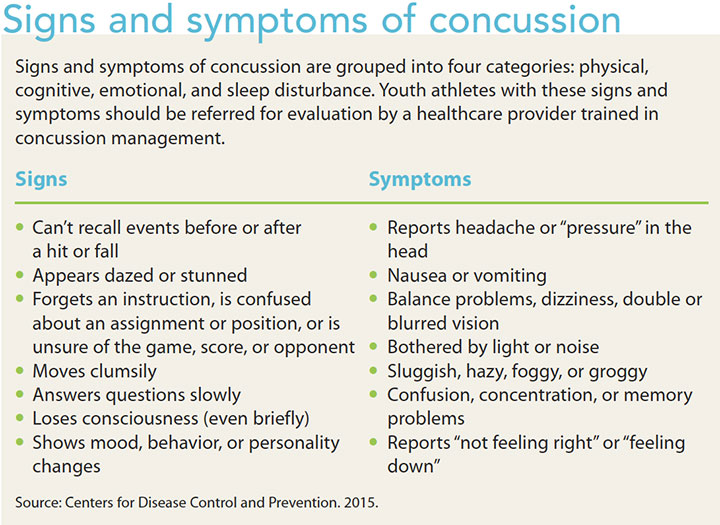

The Sport Concussion Assessment Tool–3rd Edition (SCAT3™) combines elements of several other assessments, creating a comprehensive evaluation both initially and in comparison serial follow-ups. A version of the tool has been designed for use with children under 13 years old. SCAT3 recommends emergency management in those with a Glasgow Coma Scale of less than 15; a deteriorating, progressive, or worsening mental status; a potential for spinal cord injury; or new neurologic signs. Although SCAT3 is a common part of sports concussion programs, support for its use is inconclusive. Further research is recommended to improve SCAT3 for detecting acute concussion and as a serial assessment tool during monitoring.
Parents, coaches, trainers, teachers, and all others involved in youth sports must learn about “red flag” symptoms. (See Red flag on the play.) These symptoms, either one by itself or several, may signal that the injury has caused something more serious than a concussion and requires evaluation in the emergency department.
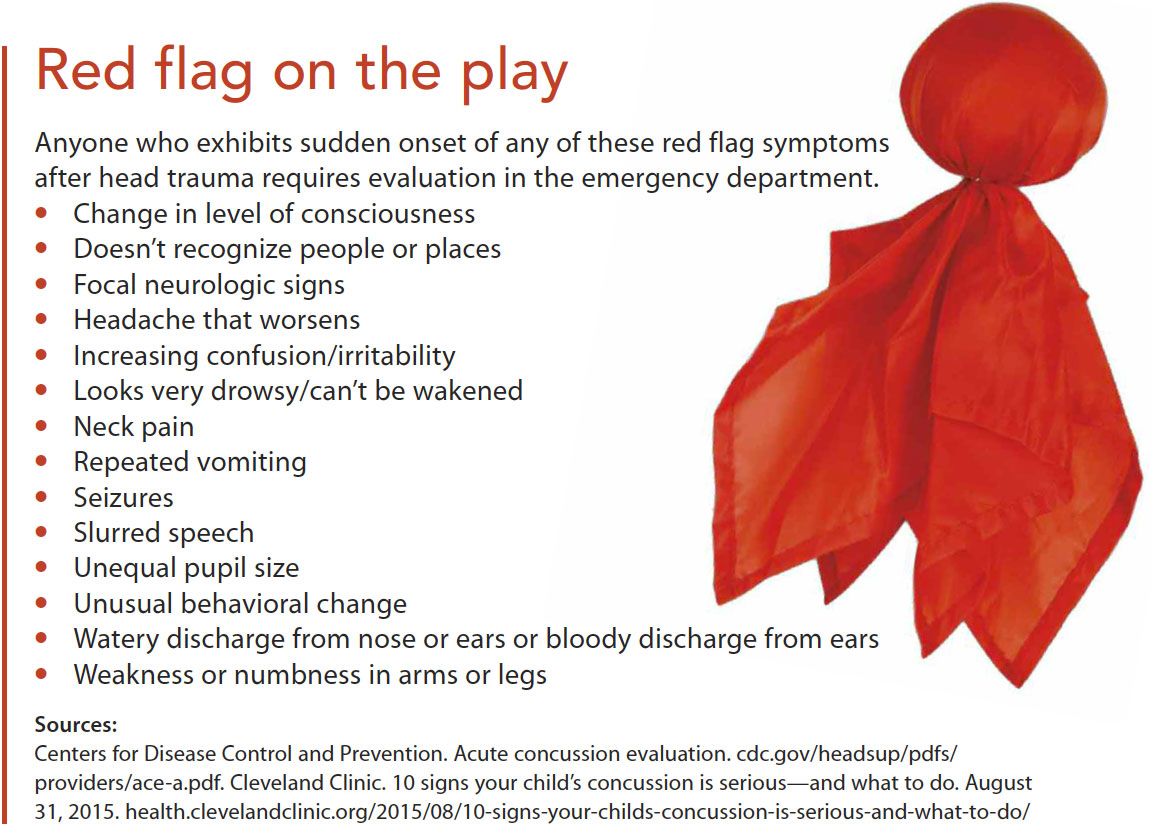

Diagnosis
A concussion diagnosis is considered when an individual presents with any of the following signs and symptoms: mental status changes (such as amnesia or confusion), physical signs (such as fatigue, blurred vision, or headache), or behavioral effects (such as irritability or personality changes).
Referral to a healthcare provider trained in concussion management will result in a systematic evaluation that includes symptom review, patient observation, palpation of the head for more severe neurologic and orthopedic injury, and specific tests for mental status and motor control. A thorough history, specifically related to prior head trauma and other pre-injury conditions, is important. Evidence suggests that patients who’ve had a concussion in the previous year are at increased risk for prolonged recovery, and those who’ve returned to play before fully recovering are at increased risk for SIS. Other research shows that patients with pre-injury learning or behavioral disabilities may have more difficult recoveries with more symptoms. However, knowing the exact description of the pre-injury disabilities will help avoid attributing those symptoms to the concussion.
Computed tomography (CT) and magnetic resonance imaging aren’t recommended for diagnosis. Diagnostic imaging is reserved for individuals who experience extended alteration of consciousness, focal neurologic deficits, or worsening symptoms; the provider may recommend a CT scan if he or she suspects intracranial bleeding, fracture, or other structural abnormality.
Neuropsychologic testing, administered via paper and pencil or computer, may be useful in recognizing early concussion. However, current evidence shows that most concussions can be managed without this type of testing. Also, although anyone can administer the tests, a licensed clinical neuropsychologist must interpret the results.
The provider will create an individualized treatment plan, including removal from play, symptom checklists, serial patient monitoring, and a gradual return to physical and cognitive activities. Patient monitoring includes provider follow-up visits, school employee evaluations with assessment tests, and school nurse monitoring with checklists.
Management
Both physical and cognitive activity can worsen concussion symptoms and even delay recovery, so rest is the cornerstone of management. Cognitive rest includes decreasing activities that involve attention and concentration, such as reading, schoolwork, watching TV, using a computer, and playing video games. Youth athletes with neurologic effects of concussion should stay home for the first 2 to 5 days after injury, especially if symptoms persist.
However, data from the Targeted Evaluation and Active Management (TEAM) Approaches to Treating Concussion suggest that too much rest may be detrimental to some children and young adults with concussion, including those with symptoms but no early signs, such as loss of consciousness, posttraumatic amnesia, disorientation, or confusion. If the data show that cognitive and physical activity combined with social interaction is associated with improved outcomes in the chronic stages of traumatic brain injury (TBI), it follows that these treatment strategies may enhance recovery and decrease self-report of symptoms in some patients. The TEAM approach emphasizes using an individualized care plan. More randomized controlled trials are needed to provide data based on the evidence.
Return to learn
RTL should be tailored to the individual and carefully monitored, with any necessary academic accommodations coordinated by the nurse. Step-by-step protocols for RTL guide the progression of cognitive work. These protocols vary, but they typically include increases in learning activities for 24 hours while monitoring for symptoms. If no symptoms occur, the patient can progress. Any activity that provokes symptoms requires a step back on the protocol for 24 hours.
Return to play
Physical activity must be curtailed to prevent further injury that might result in a second concussion. When the youth athlete has been cleared to fully participate in academics and no longer requires medication to control symptoms, physical activity can be resumed slowly and gradually.
Current recommendations regarding RTP are based on consensus statements. The guidelines evolve as new data emerges. (See Emerging science.) However, the first 10 days after the initial injury pose the greatest risk for sustaining a second concussion. Stating with certainty the number of days an individual must refrain from sports participatioion in Sport states that no one with a concussion should RTP on the same day the injury is sustained. And because of the possibility of delayed symptoms, sideline testing may not fully assess the injury’s extent. Children and adolescents have longer concussion recovery times and exhibit different physiologic responses to head trauma than adults, so they should not be treated the same.
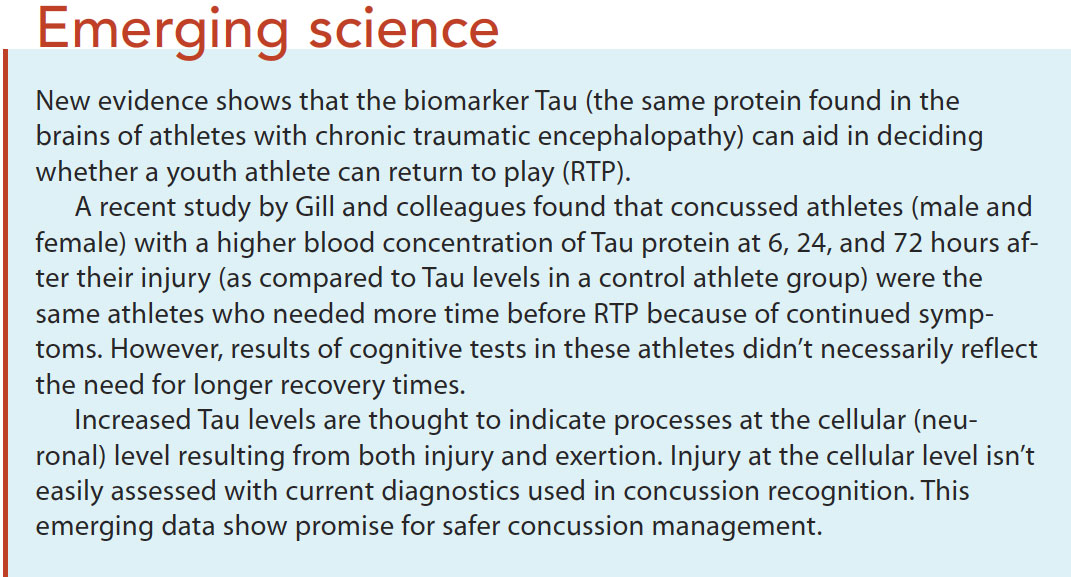

Before initiating the RTP protocol, youth athletes must be symptom free without the use of sedatives or pain medications. Before progressing to each step in the protocol, the athlete must be symptom free for 24 hours. (See RTP protocol.)
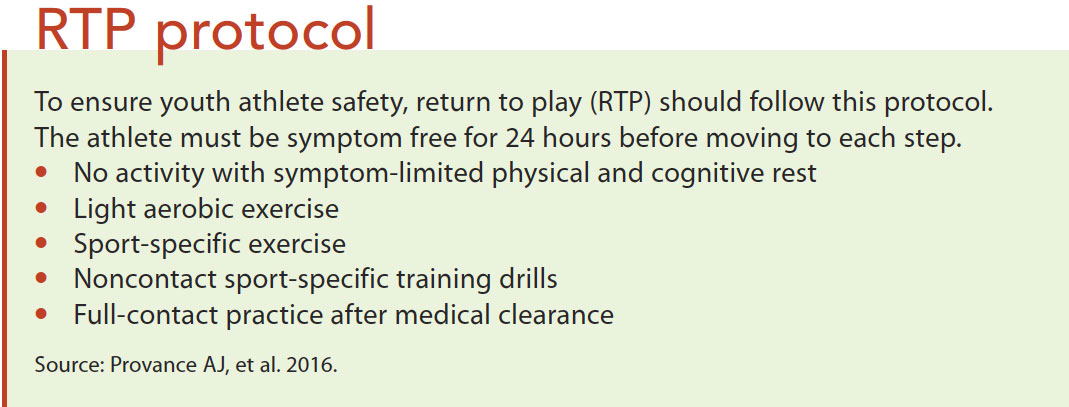

No strong evidence supports specific timing for making decisions about ending sports involvement after multiple concussions. Neuro-psychological testing may help. However, most experts agree that multiple concussions increase the risk for long-term, permanent neurobehavioral and cognitive dysfunction, and youth athletes and their families must be counseled.
Medication debate
Many concussion experts debate the use of medication after mild head trauma, with inconclusive evidence supporting the use of several classes of medications.
- Acetaminophen and nonsteroidal anti-inflammatory drugs (NSAIDs) are recommended for headache in the acute phase, although they may mask the worsening of symptoms. NSAIDs should be used with caution because they may increase the risk for bleeding.
- Amitriptyline, classified primarily as an antidepressant, has been used to manage postconcussion symptoms such as irritability, dizziness, and depression.
- Methylphenidate, classified primarily as a central nervous system stimulant, has been used to treat attention and processing-speed deficits.
- Amantadine, an antiviral and antiparkinsonian agent, has been used to improve cognition.
- Melatonin, an endogenous hormone used for the treatment of short-term sleep disturbance, is safe for use with postconcussion patients. Some evidence shows that it may play a beneficial role in brain trauma recovery.
Most patients who experience concussion have a quick recovery, so the benefit/burden of medication should be discussed with them and their family.
Nurses’ role
Nurses in school, acute care, and primary care settings are in key positions to involve interdisciplinary teams, which includes families, coaches, educators, and other healthcare providers. Nurses also can advocate for increased recognition and standardized treatment, making a significant impact on the health of young athletes.
Margaret H. Granitto is an instructor at Georgetown University School of Nursing & Health Studies in Washington, DC, and a nurse practitioner at MedStar Cardiology Associates in Annapolis, Maryland. Colleen Norton is an associate professor at Georgetown University School of Nursing & Health Studies and director of the BSN and CNL programs.
Selected references
Almasi SJ, Wilson JJ. An update on the diagnosis and management of concussion. WMJ. 2012;111(1):21-7.
American Association of Neurological Surgeons. Concussion.
Bartnik-Olson BL, Harris NG, Shijo K, Sutton RL. Insights into the metabolic response to traumatic brain injury as revealed by (13)C NMR spectroscopy. Front Neuroenergetics. 2013;5:8.
Broglio SP, Cantu RC, Gioia GA, et al; National Athletic Trainers’ Association. National Athletic Trainers’ Association position statement: Management of sport concussion. J Athl Train. 2014;49(2):245-65.
Centers for Disease Control and Prevention. Heads up: Concussion signs and symptoms. February 16, 2015.
Centers for Disease Control and Prevention. Get a Heads Up on Concussion in Sports Policies.
Cleveland Clinic. 10 signs your child’s concussion is serious—and what to do. August 31, 2015.
Gill J, Merchant-Borna K, Jeromin A, Livingston W, Bazarian J. Acute plasma tau relates to prolonged return to play after concussion. Neurology. 2017;88(6):595-602.
Gillooly D. Current recommendations on management of pediatric concussions. Pediatr Nurs. 2016;42(5):217-22.
Giza CC, Kutcher JS, Ashwal S, et al. Summary of evidence-based guideline update: Evaluation and management of concussion in sports: Report of the Guideline Development Subcommittee of the American Academy of Neurology. Neurology. 2013;80(24):2250-7.
Gómez JE, Hergenroeder AC. New guidelines for management of concussion in sport: Special concern for youth. J Adolesc Health. 2013;53(3):311-13.
Iverson, GL. Outcome from mild traumatic brain injury. Curr Opin Psychiatry. 2005;18(3):301-17.
Macdonald I, Hauber R. Educating parents on sports-related concussions. J Neurosci Nurs. 2016;48(6):297-302.
Maldonado MD, Murillo-Cabezas F, Terron MP, et al. The potential of melatonin in reducing morbidity-mortality after craniocerebral trauma. J Pineal Res. 2007;42(1):1-11.
Masferrer R, Masferrer M, Prendergast V, Harrington, TR. Grading scale for cerebral concussions. Barrow Neurological Institute.
Mayo Clinic. Post-concussion syndrome.
McCrory P, Meeuwisse WH, Aubry M, et al. Consensus statement on concussion in sport: The 4th International Conference on Concussion in Sport held in Zurich, November 2012. Br J Sports Med. 2013;47(5):250-8.
Meehan WP 3rd. Concussion therapies: Amantadine shows potential in treating post-concussion syndrome. momsTEAM.
Meehan WP 3rd. Medical therapies for concussion. Clin Sports Med. 2011;30(1):115-24.
National Research Council; Institute of Medicine; Board on Children, Youth, and Families et al. Concussion recognition, diagnosis, and acute management. In: Sports-Related Concussions in Youth: Improving the Science, Changing the Culture. Washington, DC: National Academies Press; 2014.
Provance AJ, Engelman GH, Terhune EB, Coel RA. Management of sport-related concussion in the pediatric and adolescent population. Orthopedics. 2016;39(1):24-30.
Remaly J. Looking beyond rest to active and targeted treatments for concussion. Neurology Reviews®. 2016;24(6):1,32-3.
Second impact syndrome. Brain and Spinal Cord.org. 2017.
Weber ML, Welch CE, Parsons JT, Valovich McLeod TC. School nurses’ familiarity and perceptions of academic accommodations for student-athletes following sport-related concussion. J Sch Nurs. 2015;31(2):146-54.
West TA, Marion DW. Current recommendations for the diagnosis and treatment of concussion in sport: A comparison of three new guidelines. J Neurotrauma. 2014;31(2):159-68.
Yengo-Kahn AM, Hale AT, Zalneraitis BH, Zuckerman SL, Sills AK, Solomon GS. The sports concussion assessment tool: A systematic review. Neurosurg Focus. 2016;40(4):E6.
Zeigler T. Second impact syndrome. Sportsmd.com.
ant2-CE Concussion-118

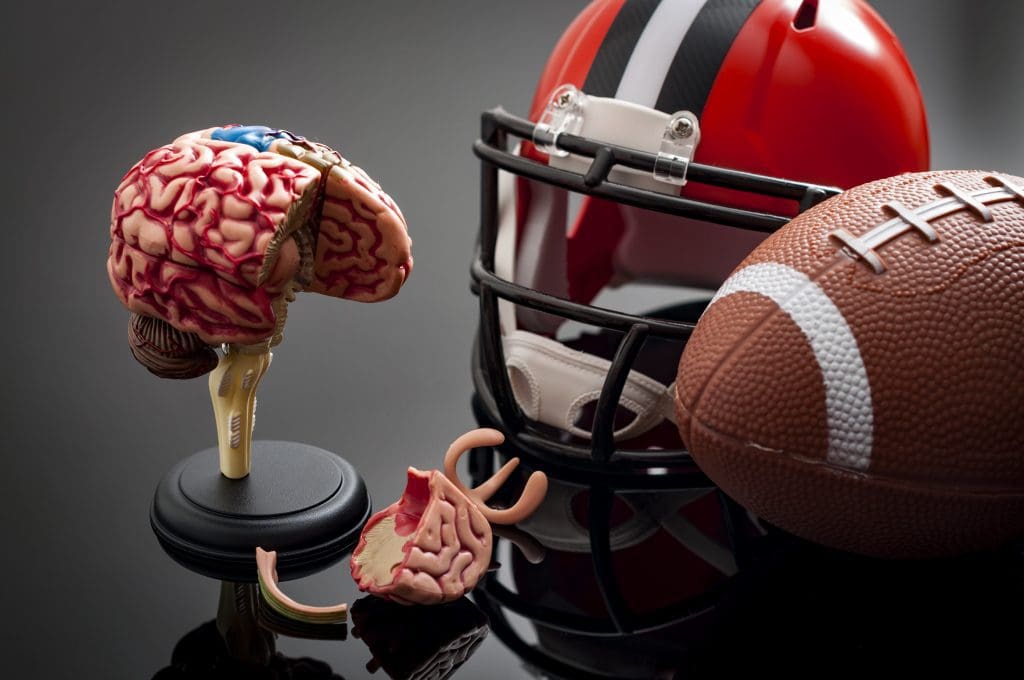

















2 Comments.
I didn’t know that a person whos had a concussion could have symptoms such as blurry vision, confusion and can be irritable. My brother’s friend was in an accident and we think he might have had a conclusion. after he hit his head he was very confused. I’m going to suggest he goes to a brain injury rehabilitation to see if they can diagnose and treat him in case the did have a concussion.
when will registration be available? Ready to take test